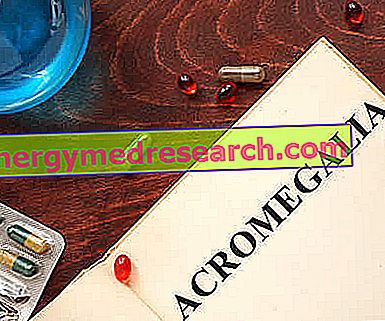Definition
Acromegaly is a rare, chronic and debilitating syndrome characterized by excessive production of growth hormone (also known as GH, from the English "Growth Hormone") and which affects adult patients. In fact, this disease is often diagnosed between 20 and 50 years of age, therefore after the phase of puberty.
Causes
As mentioned, acromegaly is caused by excessive production of growth hormone. This excessive production is often caused by the presence of a particular type of benign tumor that affects the pituitary gland, ie the gland responsible for producing the same GH. More in detail, the tumor we are talking about is GH-secreting pituitary adenoma.
However, the presence of a pituitary tumor is not the only factor that can lead to the development of acromegaly. In fact, even the use of growth hormone-based pharmacological treatments to increase muscle mass can promote the onset of this syndrome.
Symptoms
In patients with acromegaly, there is an excessive volume increase in the bones and soft tissues which leads to alterations of the hands, feet, supraorbital arches, jaw and jaw (mandibular and maxillary prognathism).
These characteristic symptoms, however, evolve rather slowly, so much so that often acromegaly is noticed only when it is already at an advanced stage.
Furthermore, in patients with acromegaly, visceromegaly, headache (due to the presence of the pituitary tumor), increased appetite, joint and muscle pain, swelling or joint stiffness, glycosuria, hyperglycemia, insulin resistance, hyperhidrosis, hirsutism, hyperprolactinemia may also occur hypertension, galactorrhoea, amenorrhea or changes in the menstrual cycle, erectile dysfunction, prognathism, hoarseness, dental malocclusion, etc.
Information on Acromegaly - Drugs for the Treatment of Acromegaly is not intended to replace the direct relationship between health professional and patient. Always consult your doctor and / or specialist before taking Acromegaly - Acromegaly Drugs.
drugs
The purpose of treating acromegaly is to decrease the production of growth hormone and reduce any pituitary tumor mass. For this reason, specific drugs are usually prescribed such as somatostatin analogues, bromocriptine and receptor antagonists for growth hormone.
Surgery can be used to remove the tumor mass. In the event that this is not possible, or if the surgery has not led to the desired results, the doctor may decide to intervene by subjecting the patient to radiation therapy. However, this latter approach is considered a second choice treatment.

Somatostatin analogues
Somatostatin analogues are drugs of synthetic origin whose chemical structure resembles, precisely, that of somatostatin (an endogenous hormone that inhibits the release of growth hormone). These active ingredients have specific therapeutic indications for the treatment of acromegaly.
- Octreotide (Sandostatin ®): Octreotide is available in pharmaceutical formulations suitable for intravenous or subcutaneous administration. The intravenous administration of the drug can only be performed by specialized personnel, while the subcutaneous injection can also be practiced by the patients themselves, but only after having received adequate preparation by the doctor or nurse.
The exact amount of octreotide to be used for the treatment of acromegaly must be established by the doctor.
- Lanreotide (Ipstyl ®): this active ingredient is available as a prolonged release suspension for injection which must be administered intramuscularly. Also in this case, the dose of lanreotide to be used must be established by the doctor on an individual basis for each patient.
bromocriptine
Bromocriptine (Bromocriptine Dorom ®) is an agonist of dopaminergic receptors of semisynthetic origin that derives from the natural alkaloid ergotamine.
It is a drug that can be used to treat different types of disorders and diseases, including acromegaly.
Bromocriptine is available in pharmaceutical formulations suitable for oral administration. The initial dose of bromocriptine that is usually used is 2.5 mg a day. Subsequently, the doctor will gradually increase the amount of the drug until the ideal maintenance dosage is reached for each patient. However, generally, the maintenance dose varies from 10 to 20 mg of bromocriptine per day.
Growth hormone receptor antagonists
Usually, growth hormone receptor antagonists are administered in those patients who do not respond to other therapeutic strategies undertaken against acromegaly. These drugs - as antagonists of the GH receptor - prevent the latter from carrying out its excessive activity underlying the development of acromegaly, thus allowing an improvement in the quality of life of patients suffering from this syndrome.
- Pegvisomant (Somavert ®): the usual starting dose of pegvisomant is 80 mg, to be administered subcutaneously under the direct supervision of a doctor. Subsequently, the dose can be reduced to 10 mg of active ingredient a day, to be always administered by subcutaneous injection.



